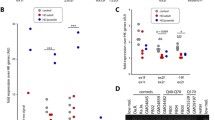Abstract
Huntington's disease, a neurodegenerative disorder characterized by loss of striatal neurons, is caused by an expanded, unstable trinucleotide repeat in a novel 4p16.3 gene. To lay the foundation for exploring the pathogenic mechanism in HD, we have determined the structure of the disease gene and examined its expression. TheHD locus spans 180 kb and consists of 67 exons ranging in size from 48 bp to 341 bp with an average of 138 bp. Scanning of theHD transcript failed to reveal any additional sequence alterations characteristic of HD chromosomes. A codon loss polymorphism in linkage disequilibrium with the disorder revealed that both normal and HD alleles are represented in the mRNA population in HD heterozygotes, indicating that the defect does not eliminate transcription. The gene is ubiquitously expressed as two alternatively polyadenylated forms displaying different relative abundance in various fetal and adult tissues, suggesting the operation of interacting factors in determining specificity of cell loss. TheHD gene was disrupted in a female carrying a balanced translocation with a breakpoint between exons 40 and 41. The absence of any abnormal phenotype in this individual argues against simple inactivation of the gene as the mechanism by which the expanded trinucleotide repeat causes HD. Taken together, these observations suggest that the dominant HD mutation either confers a new property on the mRNA or, more likely, alters an interaction at the protein level.
Similar content being viewed by others
Literature Cited
Martin, J.B., and Gusella, J.F. (1986).N. Engl. J. Med. 315:1267–1276.
Gusella, J.F., Wexler, N.S., Conneally, P.M., Naylor, S.L., Anderson, M.A., Tanzi, R.E., Watkins P.C., Ottina, K., Wallace, M.R., Sakaguchi, A.Y., Young, A.B., Shoulson, I., Bonilla, E., and Martin, J.B., (1983).Nature 306:234–238.
Gusella, J.F., and MacDonald, M.E. (1993). In: Molecular Genetic Medicine,Vol. II, (ed.) Friedmann, T. (Academic Press, San Diego), pp. 139–158.
MacDonald, M.E., Novelletto, A., Lin, C., Tagle, D., Barnes, G., Bates, G., Taylor, S., Allitto, B., Altherr, M., Myers, R., Lehrach, H., Collins, F.S., Wasmuth, J.J., Frontali, M., and Gusella, J.F. (1992).Nature Genet. 1:99–103.
Buckler, A.J., Chang, D.D., Graw, S.L., Brook, J.D., Haber, D.A., Sharp, P.A., and Housman, D.E. (1991).Proc. Natl. Acad. Sci. U.S.A. 88:4005–4009.
Church, D.M., Banks, L.T., Rogers, A.C., Graw, S.L., Housman, D.E., Gusella, J.F., and Buckler, A.J. (1993).Hum. Mol. Genet. (in press).
The Huntington's Disease Collaborative Research Group, Group 1: MacDonald, M.E., Ambrose, C.M., Duyao, M.P., Myers, R.H., Lin, C., Srinidhi, L., Barnes, G., Taylor, S.H., James, M., Groot, N., MacFarlane, H., Jenkins, B., Anderson, M.A., Wexler, N.S., and Gusella, J.F.; Group 2: Bates, G.P., Baxendale, S., Hummerich, H., Kirby, S., North, M., Youngman, S., Mott, R., Zehetner, G., Sedlacek, Z., Poustka, A., Frischauf, A.M., and Lehrach, H.; Group 3: Buckler, A.J., Church, D., Doucette-Stamm, L., O'Donovan, M.C., Riba-Ramirez, L., Shah, M., Stanton, V.P., Strobel, S.A., Draths, K.M., Wales, J.L., Dervan, P., and Housman, D.E.; Group 4: Altherr, M., Shiang, R., Thompson, L., Fielder, T., and Wasmuth, J.J.; Group 5: Tagle, D., Valdes, J., Elmer, L., Allard, M., Castilla, L., Swaroop, M., Blanchard, K., and Collins, F.S.; Group 6: Snell, R., Holloway, T., Gillespie, K., Datson, N., Shaw, D., and Harper, P.S. (1993).Cell 72:971–983.
Anderson, M.A., and Gusella, J.F. (1984).In Vitro 20:856–858.
Smith, B., Skarecky, D., Bengtsson, U., Magenis, R.E., Carpenter, N., and Wasmuth, J.J. (1988).Am. J. Hum. Genet. 42:335–344.
Lin, C.S., Altherr, M., Bates, G., Whaley, W.L., Read, A.P., Harris, R., Lehrach, H., Wasmuth, J.J., Gusella, J.F., and MacDonald, M.E. (1991).Somat. Cell Mol. Genet. 17:481–488.
Baxendale, S., MacDonald, M.E., Mott, R., Francis, F., Lin, C., Kirby, S.F., James, M., Zehetner, G., Hummerich, H., Valdes, J., Collins, F.S., Deaven, L.J., Gusella, J.F., Lehrach, H., and Bates, G.P. (1993).Nature Genet. 4:181–186.
Sanger, T., Nicklen, S., and Coulson, A.R. (1977).Proc. Natl. Acad. Sci. U.S.A. 74:5463–5467.
McClatchey, A.I., Lin, C.S., Wang, J., Hoffman, E.P., Rojas, C., and Gusella, J.F. (1992).Hum. Mol. Genet. 1:521–527.
Gusella, J.F., Varsanyi-Breiner, A., Kao, F.T., Jones, C., Puck, T.T., Keys, C., Orkin, S., and Housman, D.E. (1979).Proc. Natl. Acad. Sci. U.S.A. 76:5239–5243.
Feinberg, A.P., and Vogelstein, B. (1984).Anal. Biochem. 137:266–267.
Ambrose, C., James, M., Barnes, G., Lin, C., Bates, G., Altherr, M., Duyao, M., Groot, N., Church, D., Wasmuth, J.J., Lehrach, H., Housman, D., Buckler, A., Gusella, J.F., and MacDonald, M.E., (1992).Hum. Mol. Genet. 1:697–703.
Orita, M., Suzuki, Y., Sekiya, T., and Hayashi, K. (1989).Genomics 5:874–879.
Myers, R.H., Leavitt, J., Farrer, L.A., Jagadeesh, J., McFarlane, H., Mark, R.J., and Gusella, J.F. (1989).Am. J. Hum. Genet. 45:615–618.
Lin, B., Rommens, J.M., Graham, R.K., Kalchman, M., MacDonald, H., Nasir, J., Delaney, A., Goldberg, Y.P., and Hayden, M. (1993).Hum. Mol. Genet. 2:1541–1545.
McKeown, C., Read, A.P., Dodge, A., Stecko, O., Mercer, A., and Harris, R. (1987).J. Med. Genet. 24:410–412.
Duyao, M., Ambrose, C., Myers, R., Novelletto, A., Persichetti, F., Frontali, M., Folstein, S., Ross, C., Franza, M., Abbott, M., Gray, J., Conneally, P., Young, A., Penney, J., Hollingsworth, Z., Shoulson, I., Lazzarini, A., Falek, A., Koroshetz, W., Sax, D., Bird, E., Vonsattel, J., Bonilla, E., Alvir, J., Bickham Conde, J., Cha, J.H., Dure, L., Gomez, F., Ramos, M., Sanchez-Ramos, J., Snodgrass, S., de Young, M., Wexler, N., Moscowitz, C., Penchaszadeh, G., MacFarlane, H., Anderson, M., Jenkins, B., Srinidhi, J., Barnes, G., Gusella, J.F., and MacDonald, M.E. (1993).Nature Genet. 4:387–392.
Snell, R.G., MacMillan, J.C., Cheadle, J.P., Fenton, I., Lazarou, L.P., Davies, P., MacDonald, M.E., Gusella, J.F., Harper, P.S., and Shaw, D.J. (1993).Nature Genet. 4:393–397.
Andrew, S.E., Goldberg, Y.P., Kremer, B., Telenius, H., Theilmann, J., Adam, S., Starr, E., Squitieri, F., Lin, B., Kalchman, M.A., Graham, R.K., and Hayden, M.R. (1993).Nature Genet. 4:398–403.
Author information
Authors and Affiliations
Rights and permissions
About this article
Cite this article
Ambrose, C.M., Duyao, M.P., Barnes, G. et al. Structure and expression of the Huntington's disease gene: Evidence against simple inactivation due to an expanded CAG repeat. Somat Cell Mol Genet 20, 27–38 (1994). https://doi.org/10.1007/BF02257483
Received:
Issue Date:
DOI: https://doi.org/10.1007/BF02257483




